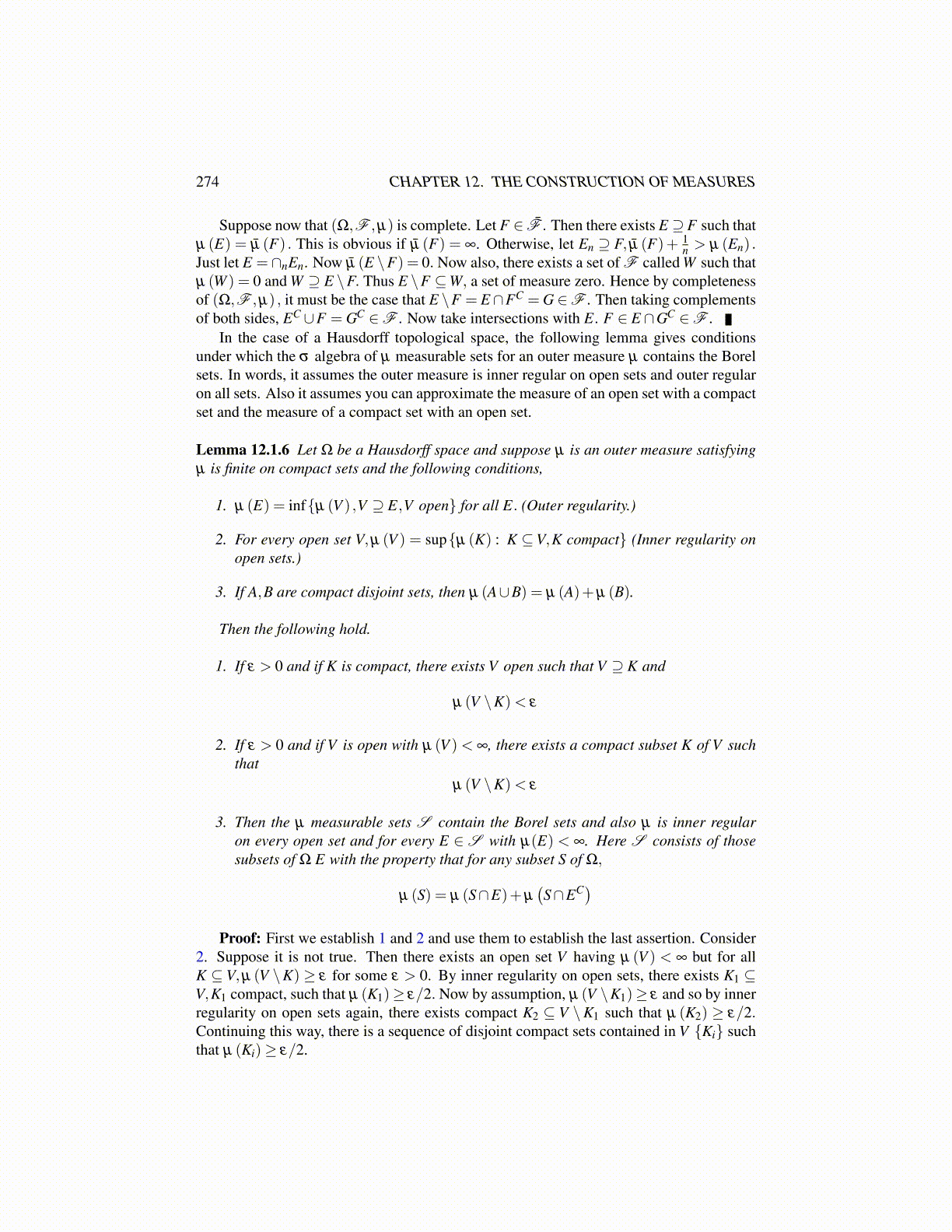
274 CHAPTER 12. THE CONSTRUCTION OF MEASURES
Suppose now that (Ω,F ,µ) is complete. Let F ∈ F̄ . Then there exists E ⊇ F such thatµ (E) = µ̄ (F) . This is obvious if µ̄ (F) = ∞. Otherwise, let En ⊇ F, µ̄ (F)+ 1
n > µ (En) .Just let E =∩nEn. Now µ̄ (E \F) = 0. Now also, there exists a set of F called W such thatµ (W ) = 0 and W ⊇ E \F. Thus E \F ⊆W, a set of measure zero. Hence by completenessof (Ω,F ,µ) , it must be the case that E \F = E∩FC = G ∈F . Then taking complementsof both sides, EC ∪F = GC ∈F . Now take intersections with E. F ∈ E ∩GC ∈F .
In the case of a Hausdorff topological space, the following lemma gives conditionsunder which the σ algebra of µ measurable sets for an outer measure µ contains the Borelsets. In words, it assumes the outer measure is inner regular on open sets and outer regularon all sets. Also it assumes you can approximate the measure of an open set with a compactset and the measure of a compact set with an open set.
Lemma 12.1.6 Let Ω be a Hausdorff space and suppose µ is an outer measure satisfyingµ is finite on compact sets and the following conditions,
1. µ (E) = inf{µ (V ) ,V ⊇ E,V open} for all E. (Outer regularity.)
2. For every open set V,µ (V ) = sup{µ (K) : K ⊆V,K compact} (Inner regularity onopen sets.)
3. If A,B are compact disjoint sets, then µ (A∪B) = µ (A)+µ (B).
Then the following hold.
1. If ε > 0 and if K is compact, there exists V open such that V ⊇ K and
µ (V \K)< ε
2. If ε > 0 and if V is open with µ (V )< ∞, there exists a compact subset K of V suchthat
µ (V \K)< ε
3. Then the µ measurable sets S contain the Borel sets and also µ is inner regularon every open set and for every E ∈S with µ(E) < ∞. Here S consists of thosesubsets of Ω E with the property that for any subset S of Ω,
µ (S) = µ (S∩E)+µ(S∩EC)
Proof: First we establish 1 and 2 and use them to establish the last assertion. Consider2. Suppose it is not true. Then there exists an open set V having µ (V ) < ∞ but for allK ⊆ V,µ (V \K) ≥ ε for some ε > 0. By inner regularity on open sets, there exists K1 ⊆V,K1 compact, such that µ (K1)≥ ε/2. Now by assumption, µ (V \K1)≥ ε and so by innerregularity on open sets again, there exists compact K2 ⊆ V \K1 such that µ (K2) ≥ ε/2.Continuing this way, there is a sequence of disjoint compact sets contained in V {Ki} suchthat µ (Ki)≥ ε/2.